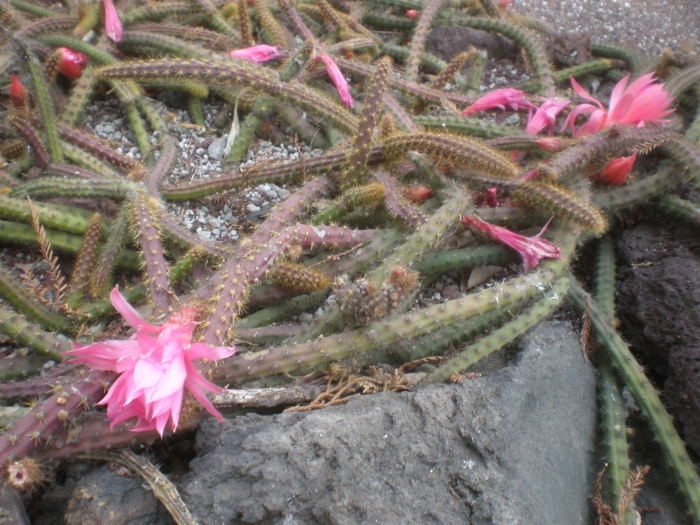Rat Tail Cactus
(Aporocactus flagelliformis)
Rat Tail Cactus (Aporocactus flagelliformis)
/
/

Consultaplantas
CC BY-SA 4.0
Image By:
Consultaplantas
Recorded By:
Copyright:
CC BY-SA 4.0
Copyright Notice:
Photo by: Consultaplantas | License Type: CC BY-SA 4.0 | License URL: http://creativecommons.org/publicdomain/zero/1.0/deed.en | Uploader: Consultaplantas | Publisher: Wikimedia Commons |












Estimated Native Range
Summary
Aporocactus flagelliformis, commonly known as Rat Tail Cactus, is an evergreen succulent native to the semi-desert regions of Mexico. It typically grows to a height and width of 0.5-1 feet, with long, trailing stems that can reach several feet in length if left unpruned. The stems are covered with small spines and produce vibrant, tubular flowers in shades of purple and red during the spring and summer months, which are quite showy and add ornamental value. This cactus is particularly noted for its ease of maintenance and its suitability for growing in containers, making it a popular choice for indoor and outdoor cultivation.
Rat Tail Cactus thrives in full sun to part shade and requires very low to low amounts of water, preferring well-draining soil. It is often grown as an ornamental potted plant, ideal for hanging baskets due to its cascading growth habit. In cultivation, it is appreciated for its drought tolerance and unique appearance. The plant should be grown in bright, indirect light and in a potting mix that is rich yet drains well, such as a blend of sandy loam with sand and crushed brick. Repotting every other year is recommended to refresh the soil without necessarily increasing pot size. During the active growing season from April to October, the soil should be kept moist, while in the dormant period from November to March, watering should be reduced. Pruning old or discolored stems in winter encourages new growth. The Rat Tail Cactus has been recognized with the Royal Horticultural Society’s Award of Garden Merit for its qualities as a garden plant.CC BY-SA 4.0
Rat Tail Cactus thrives in full sun to part shade and requires very low to low amounts of water, preferring well-draining soil. It is often grown as an ornamental potted plant, ideal for hanging baskets due to its cascading growth habit. In cultivation, it is appreciated for its drought tolerance and unique appearance. The plant should be grown in bright, indirect light and in a potting mix that is rich yet drains well, such as a blend of sandy loam with sand and crushed brick. Repotting every other year is recommended to refresh the soil without necessarily increasing pot size. During the active growing season from April to October, the soil should be kept moist, while in the dormant period from November to March, watering should be reduced. Pruning old or discolored stems in winter encourages new growth. The Rat Tail Cactus has been recognized with the Royal Horticultural Society’s Award of Garden Merit for its qualities as a garden plant.CC BY-SA 4.0
Plant Description
- Plant Type: Succulent
- Height: 0.5-1 feet
- Width: 0.5-1 feet
- Growth Rate: Moderate
- Flower Color: Purple, Red
- Flowering Season: Spring, Summer
- Leaf Retention: Evergreen
Growth Requirements
- Sun: Full Sun, Part Shade
- Water: Very Low, Low
- Drainage: Fast
Common Uses
Drought Tolerant, Low Maintenance, Potted Plant, Showy Flowers
Natural Habitat
Native to semi-desert regions of Mexico
Other Names
Common Names: Rattail Cactus
Scientific Names: , Disocactus flagelliformis, Cactus flagelliformis, Aporocactus flagelliformis, Cereus flagelliformis, Selenicereus innesii, Aporocactus flagriformis, Aporocactus leptophis, ×Aporberocereus innesii, Aporocactus flagelliformis var. leptophis
GBIF Accepted Name: Aporocactus flagelliformis (L.) Lem.